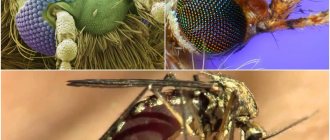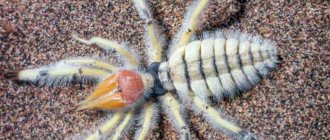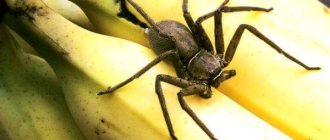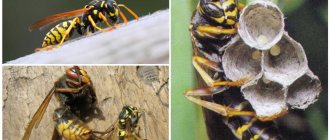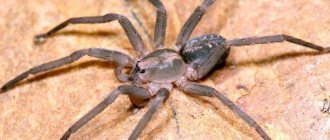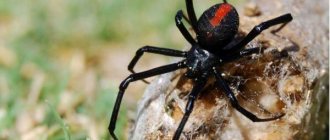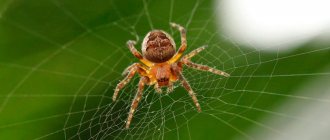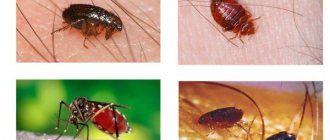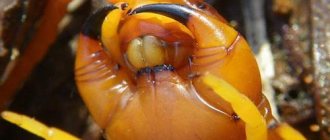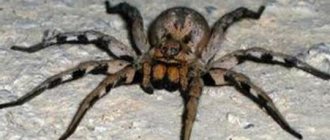The karakurt spider usually lives in regions with hot and dry climates. However, changes in weather conditions have led to the spread of the insect to areas located much north of its usual habitats. It is increasingly found in regions where it was previously impossible to see it. At the same time, the karakurt bite is dangerous for humans and domestic animals.
Let's consider where the poisonous spider lives, whether a karakurt bite is fatal, what symptoms appear, what measures include first aid and treatment, whether there will be consequences, how to deal with the insect at home and in the country.
Who is Karakurt
This is a poisonous spider belonging to the black widow family. In total, more than 30 species of the family are known, which are found on all continents of the planet, of which 8 live in Eurasia. All of them are dangerous to humans. The name of the genus, black widow, is explained by the fact that the female eats the male karakurt after mating.
The body of the spider has a black spherical shape. The coloring of different types of karakurt differs in shades of spots - from bright red in steppe representatives, to white-brown in European ones. A characteristic feature of spiders is the shape of their legs, which resemble a comb.
The population of karakurts in nature is regulated by their natural enemies - wasps and hedgehogs. Insects from the order of riders use the spider's cocoon for their own eggs, thereby destroying its offspring. Sheep and pigs trample their clutches as they move across the pasture.
The size of the karakurt depends on gender. The female can reach two centimeters, and the male does not exceed 1 cm, usually about 7 mm in length.
Karakurt bites the victim using chelicerae (jaws), and then injects the secretion of poisonous glands. Therefore, having examined the wound, you can see two small spots located nearby. Only female karakurts are dangerous to people. The male's small jaws prevent him from piercing human skin.
Where in Russia does the karakurt live?
The spider is found in the Middle East, Africa, Central Asia, and Europe. In Russia, it mainly lives in the southern regions - in the Caucasus, Crimea, Azov region, and Black Sea region. It can be found in the Astrakhan, Rostov, Volgograd regions, Krasnodar Territory. Karakurt gives preference to steppe regions.
Usually the spider weaves its web near the ground on bushes. To reproduce, it builds a den in animal burrows and soil crevices, but can also crawl into various buildings and garden plots. The optimal conditions for it are sparse thickets along the banks of lakes and rivers, in ravines, and in wastelands. Karakurt can also be found near human settlements - in heaps of garbage, isolated bushes on the beach, in a ditch, near barns, in a crevice in a clay wall. The black widow usually lives in dark corners. Its masonry can even be found under the hood of a car. The web is located 30–50 cm from the ground and is distinguished by its asymmetry and increased strength.
In hot years, the range of karakurt expands. To reproduce, they migrate, carried by the wind on webs and seeking protected mating sites. During long periods of hot weather, karakurt can be found even in the Moscow region, Chelyabinsk, Orenburg, Saratov regions. And the habitats in the Novosibirsk region and Altai have become completely uncharacteristic for this species.
The reasons for the atypical settlement of karakurts are a long period of hot weather, as well as human importation of southern vegetables and fruits along with them. But usually the spiders then die in the cold winter conditions.
Karakurt poison
It contains enzymes and a protein neurotoxin - alpha-latrotoxin, which is the main active ingredient. The poison selectively affects presynaptic nerve endings. The presence of a neurotransmitter is necessary for the transmission of a nerve impulse, but alpha-latrotoxin depletes its reserves at the synapses.
After a bite, the victim initially develops painful muscle contractions that spread throughout the body. In the future, with severe poisoning, karakurt poison causes paralysis, including the respiratory muscles. All changes occurring in the human body are united by the name - latrodectism.
Animals - rodents, horses, camels, cattle - also suffer from a karakurt bite. Dogs, hedgehogs, and reptiles react less to poison.
Complications and consequences
The saddest consequence of a black widow bite is death. It occurs if the person who was bitten was not provided with timely assistance. Today, there are effective drugs to neutralize the poison. However, the victim may not have time to get to the hospital. This happens if a person is intolerant to poison or a young child is bitten.
Other consequences of a bite include disorders of the autonomic nervous system and cardiovascular pathologies.
Why is karakurt dangerous?
The spider itself does not attack, it attacks only when defending itself. Poisoning caused by a bite does not become any less toxic. Females are more dangerous to humans.
A burning pain appears immediately, quickly spreading from the bite site throughout the body and localizing in the abdomen, lower back, and chest. Abdominal tension, priapism (painful erection), bronchospasm, and prolonged absence of the urge to defecate and urinate may appear. Then excitement gives way to depression, deterioration of consciousness, and delirium.
A karakurt bite can be fatal to children or the elderly.
The most dangerous periods are associated with the mating season - June, July, August. At this time, the female is looking for a place for a new nest. The threat of a collision with a poisonous spider increases during the seasons of active outdoor recreation and collection of plant materials. Summer is a time of intensive work in the garden, in gardens, on agricultural fields and lands. A karakurt bite can be caused by walking in thickets of grass, turning over stones, or working on making hay. A person's carelessness provokes an attack by a poisonous spider and severe poisoning.
Karakurt spider
Symptoms of a black widow bite
The black widow is a poisonous spider that lives in our area. An arthropod bite is fatal. Since the insect is small in size, it cannot always be seen, so you can easily run into it due to carelessness.
For this reason, you need to know how to identify a black widow spider bite. Symptoms include :
- at the initial stage, the bite is not accompanied by pain. A small red spot appears on the skin, but it quickly disappears. The teeth wounds cannot be seen;
- after 15-30 minutes severe pain appears, it spreads to the abdomen and lower back;
- severe tension in the abdominal muscles occurs;
- legs go numb;
- breathing becomes difficult and intermittent;
- a strong fear of death appears;
- strong mental agitation;
- vomit;
- convulsions;
- blue face;
- slow, intermittent pulse.
Over time, strong excitement gives way to lethargy and drowsiness. However, strong feelings of pain make it difficult to fall asleep. Symptoms continue for 2-3 days. The person bitten feels very weak for a long time.
Symptoms of a bite
Karakurt poison triggers a complex mechanism. The psychotropic effect is expressed by a change in the victim’s behavior. Neurotoxic effects affect muscle tone.
The clinical picture manifests itself in the process of absorption of the poison. The karakurt bite site turns red and becomes swollen. After 10–15 minutes, the first signs of poisoning appear:
- after a karakurt bite, severe pain spreads throughout the body, affecting the limbs, back, stomach, lower back, and chest;
- restless behavior, expressing fear of death;
- chills;
- thirst;
- visual hallucinations;
- excessive sweating;
- lacrimation;
- nausea, vomiting;
- increased body temperature;
- involuntary shaking (tremor) and muscle twitching;
- shortness of breath, bronchospasm, followed by paralysis of the respiratory muscles;
- an increase and then a decrease in blood pressure, heart rhythm disturbances;
- urinary retention.
A characteristic syndrome is a “latrodectic face,” distorted by pain and fear, drenched in sweat, with swollen, reddened eyelids.
The severity of poisoning depends on the initial condition of the victim. The risk group includes elderly and senile people, children, and patients with chronic diseases.
Is it possible to die from a karakurt bite? - Yes. In the absence of specialized medical care, acute cardiac and respiratory failure develops with circulatory arrest. The introduction of a specific antidote for a karakurt bite neutralizes the effect of the poison and reduces the consequences of poisoning.
How to avoid a karakurt spider bite
Unfortunately, there are few rules on how to avoid a karakurt bite. The main rule is one: do not touch the spider under any circumstances! But this rule rarely works, since few people would think of catching a spider, even a small and inconspicuous one. No one has yet canceled arachnophobia.
The problem is that a karakurt bite is almost always an accident. Moreover, for the first 3-5 minutes the victim does not even feel that he has been bitten. And if you also take into account that the karakurt prefers to live in dry grass and cracks in the ground, and its web is hardly noticeable and does not look like an ordinary circular whip, then the likelihood of being bitten increases significantly.
Important! do not touch it under any circumstances ! No matter what size or color it is. Karakurt, being a very small spider, can cause irreparable damage to health!
But, despite this, several rules can be identified that will help you avoid meeting this dangerous representative of the fauna:
- If you live in the places listed above, you need to know everything about the spider: study basic information about the species, read the rules of behavior when biting, and look at the photo of the karakurt . Aware - armed;
- When walking in steppe, semi-steppe and desert areas, show increased attention . In particular, it is worth looking more at your feet and from time to time inspecting shoes and clothes for the presence of an uninvited guest;
- If you are going on a hike to such places, it is better to wear high shoes , pants (tucked into socks) and long sleeves. These rules also apply to hiking in areas where ticks live.
This is important, since the consequences of a karakurt bite may well be fatal. The lethality of a bite depends on many factors, and the victim does not always die after meeting this spider, but pronounced negative symptoms, including severe pain, vomiting, and convulsions, are guaranteed.
First aid for a karakurt bite
An antikarakurt serum has been developed and successfully used. Its components inactivate the poison that is absorbed into the blood. The sooner the victim gets to the hospital, where he is given an antidote, the better the prognosis of the disease.
What to do if you are bitten by a karakurt? Local signs will appear weakly. Therefore, a rapidly deteriorating general condition should be alarming. If a bite occurs, then first of all you need to do the following:
- call the ambulance service;
- put cold on the bite site;
- until medical specialists arrive, immobilize the affected part of the body if possible;
- After the ambulance arrives, inform the doctors about a suspected karakurt bite.
What else can you do? There is one folk remedy - in the first minutes after a karakurt attack, cauterize the bite site with the flame of igniting 2-3 matches connected together. It is believed that since the spider’s venom is of a protein nature, the high temperature will cause the protein to coagulate and become inactivated.
In any case, it is necessary to seek medical help, as a terminal condition may develop caused by damage to the nervous system and difficulty breathing. It is life-threatening and requires cardiopulmonary resuscitation.
Bites
Karakurt bites are fatal, and are 15 times more poisonous compared to the bite of a rattlesnake, the venom of which is enough to kill 75 people out of 100 bitten. But the spiders themselves do not attack. It is advisable to see the spider in the photo to remember what it looks like.
In the first minutes, the bite is not felt and the affected area looks like a small abrasion. Over time, this symptom begins to disappear. The pain manifests itself after 2-3 hours, and sometimes 30 minutes are enough for a person to feel aches, heaviness, and malaise.
Bite symptoms:
- body aches, mostly in the muscles of the chest, abdomen, and lower back;
- difficulty breathing, which can result in cardiac arrest;
- rapid pulse, shortness of breath, dizziness, tremor;
- weakness and vomiting;
- nervous exhaustion, depression;
- clouding of consciousness, impaired perception;
- pale face;
- lacrimation;
- sweating;
- heaviness in the chest area.
Timely treatment ensures improvement in the condition within twenty days. Asthenia and weakness sometimes persist for up to two months.
Karakurt bites are extremely dangerous during the breeding season and after laying eggs, when the concentration of their poison increases. They pose a greater threat to people with low immunity and painful allergic reactions.
Karakurt males are not able to bite through the skin of humans and some animals, and therefore are not dangerous.
Actions after a bite:
- since a spider can only bite through the skin half a millimeter, immediate cauterization of the skin is effective (in the first 2 minutes, but no later than 10) so that the poison cannot spread throughout the body;
- sometimes the solution is to apply ice to the affected area of the body before providing assistance in order to curb the rate of spread of the poison, as well as immobilize and completely rest the victim;
- urgently go to the hospital to take the antidote, which is available in the regions where the black widow lives.
A single dose of serum costs about 37 thousand rubles. In case there is no antidote, an injection of potassium permanganate (5 ml 0.1%) with the same compress at the site of the bite or magnesium sulfate 10-15% is acceptable, which will alleviate the suffering of the patient. Novocaine, calcium chloride, and magnesium hydrogen sulfate give good results.
Supportive measures after taking the antidote are:
- hot bath to relieve muscle pain;
- drink plenty of fluids to dissolve toxins;
- rubbing with alcohol;
- enemas;
- painkillers and sleeping pills to help the victim recover (Analgin, Diphenhydramine, Ketanol);
- antihistamines that reduce swelling (Suprastin, Agistam, Loratadine, Claritin).
Without medical intervention, death is possible within a day or two. The number of deaths after a karakurt bite is 4−6%, which occurs due to late admission to the hospital, a person’s predisposition to intoxication, including diseases and weak immunity.
Karakurt
Animal bites
Horses and camels are the most sensitive to a karakurt bite; the consequences for them can be fatal.
Reptiles, amphibians, dogs, sheep, pigs, hedgehogs are not susceptible to the bite of karakurt.
Circumstances of the bite
Most often, a spider attack occurs when the nests or trapping nets of an animal are violated, when the human body is pressed against the spider. This is possible while picking flowers, mowing grass, resting on the ground, or spending the night in nature.
There have been cases of spiders entering barns, woodpiles, rural buildings and latrines. If a karakurt's home is flooded during heavy rains, it is possible that it will enter the house in search of a new home.
Treatment
Medical care begins with the administration of a specific antidote to karakurt toxin - anti-karakurt serum.
Main areas of intensive care:
- adequate analgesia;
- glucocorticosteroids;
- sedatives to relieve emotional stress;
- antihistamines (antiallergic) drugs;
- infusion (intravenous drip) of saline solutions to adjust the activity of the cardiovascular system;
- restoration of neuromuscular transmission;
- breathing correction - humidified oxygen, artificial ventilation;
- relief of bronchospasm symptoms;
- restoration of urination;
- symptomatic therapy - pain-relieving eye drops, normalization of body temperature.
In the international classification of diseases ICD-10, a karakurt bite has the code X21 - “Contact with a black widow spider.”
Consequences
Positive dynamics in the condition of the victim after a karakurt bite occurs slowly. The first signs of improvement appear only after 3–5 days. If the outcome is favorable, complete recovery may occur in 2–3 weeks.
Complications of a karakurt bite:
- weakness, fatigue;
- pain in the heart, limbs, lower back;
- dizziness;
- dyspnea;
- rapid heartbeat;
- sleep disturbances, falling asleep;
- loss of appetite;
- skin rash;
- hearing loss.
The consequences depend on the initial condition of the victim. Poisoning often causes exacerbation of chronic diseases.
Complications and consequences
The consequences of a bite do not fully manifest themselves in everyone: some “get off” with relatively minor intoxication, while for others it is fatal. But most often, a black widow bite causes severe toxic and allergic reactions in the human body, and can also serve as an impetus for the development of other dangerous diseases. [25]
A bite rarely becomes simply a local injury or a limited inflammatory process in the tissues. Most often, the problem develops into severe toxic shock; cases of acute fulminant toxic myocarditis, [26] followed by the death of the victim, have been described. Mortality rates range from 5% to 10%, although these figures may be inflated. [27]
In general, the consequences of a black widow bite can appear both immediately after receiving the damage and in a long-term period. Some pathological conditions in the form of a secondary infection or neurological problems do not arise immediately, and the incubation period can last up to a couple of weeks or even a month. In this situation, the best way to prevent adverse consequences is to seek medical help as early as possible, as well as competent immediate treatment.
Is a black widow's bite fatal?
The bite of a female karakurt spider can indeed be fatal to humans, because its venom is very strong and instantly has a toxic effect. As for the karakurt male, he is not even able to bite through the skin of a person.
If the bite victim is not provided with the necessary medical care, death can occur within 24-48 hours.
Prevention
To prevent a karakurt bite, measures to prevent contact with the spider are necessary:
- maintaining cleanliness in the house;
- use of deterrents;
- application of insecticides;
- observing precautionary measures in nature during tourist outings, on the beach, and agricultural work.
Spiders feed on insects, so the extermination of moths and flies will leave the karakurt without food. Keeping the attic and roof in order and ventilating them will deprive spiders of their favorite habitats.
Experienced gardeners believe that too bright outdoor lighting at home attracts insects, and then spiders. Therefore, it is better to use “warm” LED lamps, to which midges react less.
Canopies will come in handy when traveling. When going outdoors, you must wear closed shoes and tight trousers. Avoid walking on rocky slopes at night. You have to carefully lift the stones. It is safe to carry out agricultural work wearing protective clothing. Gloves should be used when collecting medicinal plants. There is no need to leave your shoes outside or walk around the yard and garden barefoot. It is necessary to carefully inspect and shake off clothes after work. These precautions will help you avoid being bitten.
